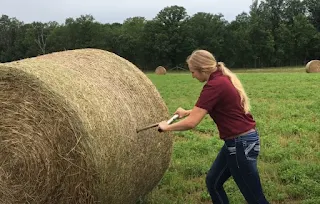Emma Severns and Troy Salzer, Extension educators-Ag production systems, and Jared Goplen, Extension educator-crops
This growing season's drought has been particularly challenging for livestock producers as forage shortages have been coupled with nitrate concerns.Forage quality testing is more important than ever this year to ensure forages are meeting your livestock's nutrient requirements and to also determine the levels of nitrates in your forages. The results from your forage analysis can help you strategically plan rations, allowing you to make the best use of your forages.
Proper sampling of a forage is especially important when feedstuffs may be variable, which is the case in many areas of Minnesota. A representative sample allows you to determine the nutritional value of your forage and determine whether or not there are toxic levels of nitrates, mycotoxins, etc. in your forages. Sampling procedures vary depending on the type of forage and if your sampling is done pre-harvest or after the forage has been stored.
Proper sampling of a forage is especially important when feedstuffs may be variable, which is the case in many areas of Minnesota. A representative sample allows you to determine the nutritional value of your forage and determine whether or not there are toxic levels of nitrates, mycotoxins, etc. in your forages. Sampling procedures vary depending on the type of forage and if your sampling is done pre-harvest or after the forage has been stored.
Hay bale samples
Use a properly sharpened bale core sampler to reduce sampling error. Sampling without a bale core probe will result in erroneous representation of stems vs. leaf material. When taking a sample from a large round bale the probe should be inserted from the rounded side into the center of the bale. Square bales should be probed from the middle of the butt end.To get a representative forage sample, it is important to mix a minimum of 12 cores per lot. A lot is a group of bales that are expected to have similar nutrient composition, such as bales harvested on the same day from the same field. After collecting the forage sample, mix the entire sample in a clean plastic pail. Then place the sample in a clean plastic bag and label properly with your name, the lot, forage type and the date. Remove as much air from the bag as possible and seal tightly.
To take a sample of bagged silage, collect about 2 gallons of silage by taking handfuls at random from approximately 10 locations and mix them in a clean bucket. Place the evenly mixed sample in a plastic bag and label it correctly.
If you aren’t sure where to send the sample, ask your local Extension educator or livestock nutritionist. They can also help advise you on which tests to request and how to interpret the sample results.
Links to several forage testing labs in MN are below:
Watch the UMN Extension produced video, How to take a forage sample, for detailed instructions on sampling baled hay.
Windrow samples
When collecting samples from windrows, it's important to take multiple samples throughout the field to ensure you are getting a representative sample. Use a sharp shear to cut 6-inch sections from the windrows and then cut the sections into 1-inch long pieces to mix in a clean container.Silage samples
Under normal conditions, it is generally acceptable to take fresh samples of silage. However, with drought conditions potentially increasing the nitrate levels to toxic levels, it is advisable to wait until the completion of the fermentation process to take a sample. This is due to the fact that the ensiling process will help reduce the amount of nitrates during fermentation, so test results will not be accurate if fresh samples are taken. Any suspect feed should be tested for nitrate levels before feeding.To take a sample of bagged silage, collect about 2 gallons of silage by taking handfuls at random from approximately 10 locations and mix them in a clean bucket. Place the evenly mixed sample in a plastic bag and label it correctly.
When to sample
Sampling immediately after harvest can provide you with valuable information for marketing your forages and when making feeding plans. Collecting samples close to when the feed will be fed provides the most accurate estimates of the actual feed value and accounts for any storage losses that may occur after harvest. For more information on storage losses, see Forage supplies are tight: Preserve what you have!).If you aren’t sure where to send the sample, ask your local Extension educator or livestock nutritionist. They can also help advise you on which tests to request and how to interpret the sample results.
Links to several forage testing labs in MN are below:
- DHIA - Sauk Centre, MN https://z.umn.edu/ForageLabDHIA
- Dairyland labs - St. Cloud, MN https://z.umn.edu/ForageLabDairyland
- CVAS - Zumbrota, MN https://z.umn.edu/ForageLabCumberland

Comments
Post a Comment